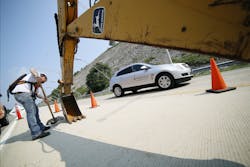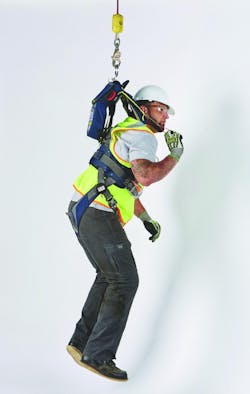Interactive PPE Keeps Workers Safer
Tom Martin, Ph.D., professor of electrical and computer engineering, Virginia Tech, will tell you that his area of research is not construction-safety or personal-protective equipment, but is, instead, “wearable computing and smart fabrics.” Martin and his fellow researchers, however, have combined all these aspects into what might be called prototypes of “interactive” personal protective equipment (PPE) for the construction industry.
According to Martin, his colleagues at the Virginia Tech Transportation Institute expect that vehicles in the not-too-distant future will have dedicated-short-range-communication (DSRC) systems that will allow cars to “talk” to each other about traffic hazards and inform drivers about these hazards. (The National Highway Traffic Safety Administration has announced intentions to require vehicle-to-vehicle—V2V—DSRC technology in cars and light trucks by 2020.)
Martin and his fellow researchers are using this technology to potentially protect workers in highway construction zones. A safety vest equipped with DSRC hardware will provide workers visual, auditory, and vibratory warnings that a vehicle is dangerously close or headed straight for them. Feasibility studies using available DSRC hardware have shown, says Martin, that such a system can give workers five to six seconds of warning against a vehicle approaching at 35 mph, and do so with 90 percent accuracy.
The technology will be viable, says Martin, when a significant number of vehicles are equipped with DSRC technology and when DSRC hardware is reduced to a smaller size, fitting into a vest pocket, perhaps. He sees no problem with miniaturizing the hardware, saying, “it’s just an engineering challenge that some manufacturer will take on.”
Another Virginia Tech research effort is aimed at interactively protecting those working around engine-powered equipment in closed spaces. A carbon-monoxide sensor in the worker’s hard hat will continuously measure the CO level in the worker’s blood and alert the worker when levels approach an unsafe threshold. The technology involved is similar to that employed by the nurse who places a clip on your finger to measure blood-oxygen levels. The clip shines a wavelength of light through the finger and measures the amount that exits. CO detection works in the same manner, but uses different wavelengths of light.
Feasibility studies using this technique with a blood-oxygen sensor in the hardhat (not wanting to subject those in the study to CO) have shown, says Martin, that active workers can be given at least six minutes warning before possibly succumbing—with 99 percent accuracy. What’s needed at this point, he says, is a commercial partner to further develop the technology.
Interactive devices
As it turns out, a number of PPE devices might be considered interactive, in the sense that they actively communicate with—or actively assist—workers.
For example, the 3M NI-100 Noise Indicator is a small device that clips to the worker’s safety vest and alerts workers when ambient sound is approaching possibly damaging levels, flashing green below 85 dB(A) and red above that threshold. 3M Hearing Protection Solutions also recently developed the E-A-Rfit Dual-Ear Validation system, which interactively measures the effectiveness of different hearing-protection devices for a specific worker by providing a personal attenuation rating (PAR) that assists in proper device selection and fitting.
Another PPE device that communicates with the wearer is the Lincoln Electric Viking 3550 Powered-Air-Purifying Respirator that notifies the wearer via audible and vibratory sensors when the filter needs changing or the battery needs charging. Perhaps also considered interactive, says Chase Rutti, product management, welding gear and tools for Lincoln, are auto-darkening welding helmets, which automatically detect the welding arc and change filter darkness. New technology, says Rutti, uses a blue/gray color spectrum that gives the wearer a more accurate view of the arc and puddle, while also reducing eye strain.
Miller Electric’s Titanium series welding helmets, such as the 9400i, also have features that might be considered interactive, such as their InfoTrak system that uses arc-tracking technology to store arc-on time and four operating modes adjusted, says Miller, via intuitive digital controls. The helmets also have an “auto on/off” feature that activates the helmet with the arc strike.
Although the examples of “interactive” PPE considered so far have an electronic or digital aspect, some interactive PPE is activity based, such as self-rescue systems. If a worker falls from a considerable height and the fall is arrested by a safety harness, the worker is in danger of experiencing suspension trauma if not rescued promptly. (If the victim faints while remaining upright in the harness, the brain can be starved of oxygen.)
To facilitate rescue, devices such as the 3M DBI-SALA Self-Rescue system allow fallen workers to lower themselves to safety. The DBI-SALA system, designed to connect to conventional safety harnesses, allows workers to lower themselves immediately after a fall from heights up to 100 feet. A secondary rescue ring allows the device to be activated by a rescuer.
“Self-rescue is the safest approach in a rescue situation, because it can be activated by the wearer immediately, and it keeps other workers in the area out of danger,” says Chris Coyle, hard goods product manager at 3M Fall Protection.
Distracted drivers
Among the most sophisticated of interactive safety systems is the Caterpillar Fatigue Risk Management System. The system incorporates several technologies that might be considered interactive, including the Driver Safety System (DSS), which uses “fatigue-detection” technology that works by monitoring the haul truck operator’s eye-closure duration and head pose. If the system detects a fatigue or distraction event, the operator is immediately alerted through in-vehicle seat vibration and/or an audio alarm.
Caterpillar safety advisors in the company’s “24/7 Fleet Monitoring Center” analyze data and video from the DSS and notify on-site personnel about drowsy or distracted driving. Each fatigue and distraction event is reviewed, verified, classified, and logged for analysis and recordkeeping.
The overall fatigue-management system also uses the Cat Smartband (powered by Fatigue Science, says the company), which is an “actigraphy watch” worn by operators to monitor sleep and wake periods. Data are then converted, says Caterpillar, into an “effectiveness score” that is viewable by the operator at the push of a button. If the score is approaching 70 percent, says Caterpillar, the employee is considered “fatigue impaired.”
Collision-avoidance systems
Systems designed to prevent workers and machines from colliding would certainly seem to be interactive.
The Armour system from Scan-Link Technologies, for example, uses radio frequency identification (RFID) to send out a radio wave from a machine’s antenna, and when the signal is reflected by a “passive” tag worn by a worker, the machine operator receives an audio/visual alert that a human is in harm’s way. The Armour system uses 10 tags around the worker’s hard hat and 14 in a vest to ensure line-of-sight contact no matter the worker’s position. An active tag, with its own battery and electronics, provides a warning for the operator as well, as can flashing lights and an alarm at the rear of the machine.
Another collision-avoidance technology, magnetic field, is used by Frederick Energy Products’ Hit-Not system. A small magnetic-field generator is attached atop a machine’s cab roof and sends out a watermelon-shaped field that envelopes the machine. The magnetic field communicates with small personal alarm devices worn by workers in proximity to the machine. Both the machine operator and the worker receive a two-stage alert (“warning,” then “danger”) as the threat of collision escalates. Because the magnetic field passes through virtually any obstruction, the Hit-Not system does not depend on line-of-sight communication.
Radar-based collision-mitigation systems have always been considered interactive with the machine operator, and combining radar detection with vision systems can virtually provide a 360-degree sensing zone around the machine. These systems continue to advance in their detection capability.
According to Doug Whitfield, director of marketing at Preco Electronics, the company’s newest system, the PreView Sentry, is designed with technical refinements, which include the ability to accurately identify the location and velocity of up to 16 people or objects simultaneously, at up to 98 feet away, and also to interactively alert the operator if the system is blocked, say, with mud or snow.
Yet another interactive collision-avoidance system is Taylor Machine Works’ Vision Plus Pedestrian Detection Aid.
Video cameras placed in strategic locations on the machine continually send images to a computer processor, which, in real time, scans the images and searches for characteristics specific to the human form, such as shape, appendages, oscillating legs, relative size, and relative motion. If the system determines that a human is within the camera’s view, then the machine operator receives an audio/visual alert via an in-cab monitor. The system also can track the paths of both a moving pedestrian and a moving machine to determine if pedestrian and machine are on a collision course.

